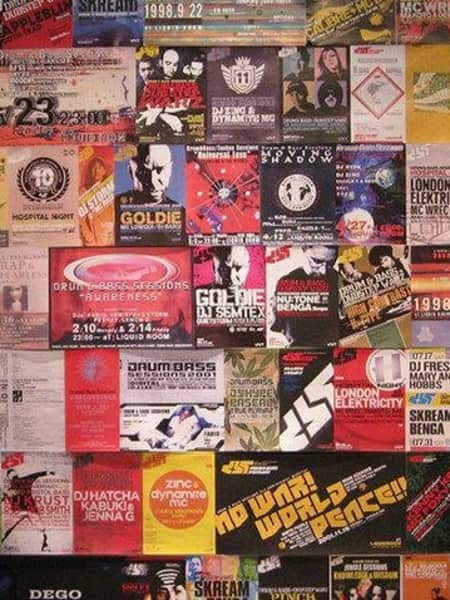Since it emerged from the UK rave scene in the early 1990s, drum 'n' bass has fractured into countless different sub genres and offshoot sounds. To the untrained ear, it might be hard to separate techstep from halftime or sort jump-up from liquid, but fear not. This handy guide will help you unravel the differences and supply you with all the skills you need to spot each sub-genre from its distinctive musical features.
Autonomic sound
A short-lived chapter in drum 'n' bass, the Autonomic sound was the product of long-standing scene producers dBridge and Instra:mental's short-lived podcasts, which also spawned the FABRICLIVE50 mix. Mixing lush synths, electro influences and minimalist beats, it took drum 'n' bass into new territory.
Example: dBridge and Instra:mental featuring Skream – Acacia Avenue
The Brazilian sound (aka Sambass)
When drum 'n' bass was stuck in a moody vacuum at the start of the 2000s, the Brazilian mob reintroduced sunshine and funk to the genre. DJ Marky, Patife, Bungle, L-Side, S.P.Y and XRS laced their version of drum 'n' bass with Brazilian samba and soul influences without sacrificing the essential beats and low-end, resulting in an addictive hybrid. DJ Marky And XRS's LK track, featuring Stamina MC, even dented the pop charts in 2002.
Example: Fernanda Porto – Sambassim (DJ Patife remix)
Breakcore
On the fringes lurks breakcore, an outsider's take on drum 'n' bass that's typified by its over-the-top drum edits and abstract electronics. Initially forged by the likes of Squarepusher, Jega and Aphex Twin, artists such as Shitmat, Kid606, Venetian Snares and DJ Scotch Egg took breakcore to its outlandish, brain-bludgeoning conclusion.
Example: Kid606 – Who Wah Kill Sound?
Darkcore
Chronologically, darkcore pitches up somewhere between the euphoric rush of hardcore rave and the heavy soundsystem pressure of jungle. Darkcore was an early blueprint of drum 'n' bass, with a moodier, tougher edge than anything that had come before. Goldie, 4Hero and DJ Crystl helped introduce the beat-chopping and brooding textures associated with drum 'n' bass proper.
Example: Rufige Crew – Terminator
Halftime
Also known as drumstep, halftime literally halves the tempo to something like a hip-hop lope, but keeps the bass and electronics rolling at full speed for club-wrecking impact. Deployed by artists such as Om Unit, Dub Phizix, Fracture, Moresounds, Kromestar and Ivy Lab, halftime owes a debt to dubstep and trap, but with the breakbeats and classic drum 'n' bass signifiers intact.
Example: Dub Phizix And Skeptical featuring Strategy – Marka
Intelligent
A dreamy, ambient alternative to the harder forms of drum 'n' bass, the intelligent sound initially sprang from the mind of LTJ Bukem and likeminded artists on his Good Looking Records label. Influenced by the drifty elements of Detroit techno and UK house, the intelligent sound – also christened artcore – mixed splintered breakbeats with warm bass and celestial atmospheres. Derided by some for being too lightweight, its accessibility and sense of melody brought many new converts into the drum 'n' bass scene.
Example: LTJ Bukem – Horizons
Jump-up
Jump-up is raw, stripped-to-the-bone and purely for the dancefloor. It combines a stepping beat with ferocious splurges of hooky electronic bass riffs and is spring-loaded, fast and fun – and very much looked down upon by drum 'n' bass purists. Still, its champions, such as DJ Hype and Twisted Individual, have been contributing to the scene from its earliest days. Just recently, a new wave of artists including Turno and Voltage have revived the genre.
Example: Turno – The Invaderz
Jungle
Jungle is the immediate forefather of drum 'n' bass and also one of the most uniquely British electronic music sounds of all time. It combines the earth-shattering bass and dub FX of reggae soundsystems, rapid-fire breakbeats from old-school hardcore and samples of gruff dancehall MCs, plus occasional ambient pads and sweet vocals. Artists such as Special Request are harnessing jungle's potency all over again.
Example: Leviticus – Burial
Liquid
As smooth as drum 'n' bass gets, liquid is characterised by its crisp beats, funky riffs, house influences, Rhodes keyboards and jazz samples. First created by artists Alex Reece and Wax Doctor, it found a home on Fabio's Creative Source label and later made it big thanks to High Contrast's True Colours album on Hospital Records, Manchester's late Marcus Intalex and the rise of prolific Irish producer Calibre. Hospital has since become synonymous with liquid and has helped to crystallise a glossy (but highly credible) form of the genre.
Example: Marcus Intalex And ST Files – Universe
Neurofunk
Neurofunk is immaculately produced android dance music with a distinctive mechanical quality. Often populated by experimental rhythms and with an oppressive dystopian vibe, labels including Critical and Eatbrain, and artists such as Noisia, Phace and Current Value have pushed this newest form of drum 'n' bass. It's a big favourite of cyber goths, too.
Example: Phace And Current Value – Wild Thing
Techstep
In the latter half of the '90s, drum 'n' bass became more commercially viable. Its biggest artists – Goldie, Roni Size and Photek– became hugely popular. Techstep was a staunchly underground reaction that eschewed melody and brought in nightmarish cyborg sounds and techno influences. With its regimented beat and dark template, it took drum 'n' bass in a new direction showcased by tracks produced by Ed Rush And Optical, Bad Company and Doc Scott. The sound has recently seen a revival of sorts and a new micro genre of harder, heavier beats called skullstep.
Example: Bad Company – The Nine






